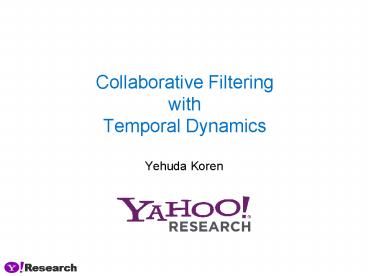Yehuda Koren PowerPoint PPT Presentation
1 / 29
Title: Yehuda Koren
1
Collaborative Filtering with Temporal Dynamics
- Yehuda Koren
2
Recommender systems
We Know What You OughtTo Be Watching This Summer
3
Collaborative filtering
- Recommend items based on past transactions of
users - Specific data characteristics are irrelevant
- Domain-free
- Can identify elusive aspects
- Two popular approaches
- Matrix factorization
- Neighborhood
4
Movie rating data
Training data
Test data
5
Achievable RMSEs on the Netflix data
Global average 1.1296
Find better items
User average 1.0651
Movie average 1.0533
Personalization
Cinematch 0.9514 baseline
Algorithmics
Static neighborhood 0.9002
Static factorization 0.8911
Time effects
Leader 0.8558 10.05 improvement
Inherent noise ????
6
Something Happened in Early 2004
2004
7
Are movies getting better with time?
8
Multiple sources of temporal dynamics
- Item-side effects
- Product perception and popularity are constantly
changing - Seasonal patterns influence items popularity
- User-side effects
- Customers ever redefine their taste
- Transient, short-term bias anchoring
- Drifting rating scale
- Change of rater within household
9
Temporal dynamics - challenges
- Multiple sources Both items and users are
changing over time - Multiple targets Each user/item forms a unique
time series ? Scarce data per target - Inter-related targets Signal needs to be shared
among users foundation of collaborative
filtering ? cannot isolate multiple problems - ? Common concept drift methodologies wont
hold.E.g., underweighting older instances is
unappealing
10
Basic matrix factorization model
users
items
users
items
A rank-3 SVD approximation
11
Estimate unknown ratings as inner-products of
factors
users
?
items
users
items
A rank-3 SVD approximation
12
Estimate unknown ratings as inner-products of
factors
users
?
items
users
items
A rank-3 SVD approximation
13
Estimate unknown ratings as inner-products of
factors
users
2.4
items
users
items
A rank-3 SVD approximation
14
Matrix factorization model
- Properties
- SVD isnt defined when entries are unknown ? use
specialized methods - Can easily overfit, sensitive to regularization
- Need to separate main effects
15
Baseline predictors
- Mean rating 3.7 stars
- The Sixth Sense is 0.5 stars above avg
- Joe rates 0.2 stars below avg
- ?Baseline predictionJoe will rate The Sixth
Sense 4 stars - No user-item interaction
16
Factor model correction
- Both The Sixth Sense and Joe are placed high on
the Supernatural Thrillers scale - ?Adjusted estimateJoe will rate The Sixth Sense
4.5 stars
17
Matrix factorization with biases
Baseline predictors µ global average bu
bias of u bi bias of i
User-item interaction pu user us factors qi
item is factors
?Minimization problem
regularization
18
Addressing temporal dynamics
- Factor model conveniently allows separately
treating different aspects - We observe changes in
- Rating scale of individual users
- Popularity of individual items
- User preferences
Baseline predictors
User factors
19
Parameterizing the model
- Use functional forms bu(t)f(u,t), bi(t)g(i,t),
pu(t)h(u,t) - Need to find adequate f(), g(), h()
- General guidelines
- Items show slower temporal changes
- Users exhibit frequent and sudden changes
- Factors pu(t) are expensive to model
- Gain flexibility by heavily parameterizing the
functions
20
Achievable RMSEs on the Netflix data
Global average 1.1296
Find better items
User average 1.0651
Movie average 1.0533
Personalization
Cinematch 0.9514 baseline
Algorithmics
Static neighborhood 0.9002
Static factorization 0.8911
Time effects
Dynamic factorization 0.8794
Grand Prize 0.8563 10 improvement
Inherent noise ????
21
Neighborhood-based CF
- Earliest and most common collaborative filtering
method - Derive unknown ratings from those of similar
items (item-item variant)
22
Neighborhood modeling
Use item-item weights - wij - to relate items
Need to estimate rating of user u for item i
Deviation from baseline estimate for item j
Baseline predictor
Weight from j to i
Set of items rated by u
constants
learned from the data through optimization
23
Optimizing the model
Minimize the squared error function
24
Making the model time-aware
- A popular scheme instance weightingdecay the
significance of outdated events within cost
function
time decay
Dont do this!
25
Why instance weighting isnt suitable?
- Not enough data per user need to exploit all
signal, including old one - The learnt parameters wij represent time
invariant item-item relations. Can be also
deduced from older actions. - Two items are related when users rated them
similarly within a short timeframe, even if this
happened long ago - How to do it right?
26
Time-aware neighborhood model
- Decay item-item relations based on time distance
- User-specific decay rate controlled by ßu
- All past user behavior is equally considered,
through cost function
27
Temporal neighborhood model delivers same
relative RMSE improvement (0.0117) as temporal
factor model (!)
Global average 1.1296
Find better items
User average 1.0651
Movie average 1.0533
Personalization
Cinematch 0.9514 baseline
Algorithmics
Static neighborhood 0.9002
Static factorization 0.8911
Dynamic neighborhood 0.8885
Time effects
Dynamic factorization 0.8794
Grand Prize 0.8563 10 improvement
Inherent noise ????
28
Lessons
- Modeling temporal effects is significant in
improving recommenders accuracy - Allow multiple time drifting patterns across
users and items - Integrate all users within a single model to
allow crucial cross-user collaboration - Model user behavior along full history, do not
over-emphasize recent actions - Separate long term values, while excluding
transient fluctuations from the model - Sudden, single-day effects are significant
- Modeling past temporal fluctuations helps in
predicting future behavior, even though we do not
extrapolate future temporal dynamics
29
Yehuda Koren Yahoo! Research yehuda_at_yahoo-inc.com

